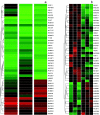Targeted cellular process profiling approach for uterine leiomyoma using cDNA microarray, proteomics and gene ontology analysis
- PMID: 14748746
- PMCID: PMC2517572
- DOI: 10.1111/j.0959-9673.2003.00362.x
Targeted cellular process profiling approach for uterine leiomyoma using cDNA microarray, proteomics and gene ontology analysis
Abstract
This study utilized both cDNA microarray and two-dimensional protein gel electrophoresis technology to investigate the multiple interactions of genes and proteins involved in uterine leiomyoma pathophysiology. Also, the gene ontology analysis was used to systematically characterize the global expression profiles at cellular process levels. We profiled differentially expressed transcriptome and proteome in six-paired leiomyoma and normal myometrium. Screening up to 17 000 genes identified 21 upregulated and 50 downregulated genes. The gene-expression profiles were classified into mutually dependent 420 functional sets, resulting in 611 cellular processes according to the gene ontology. Also, protein analysis using two-dimensional gel electrophoresis identified 33 proteins (17 upregulated and 16 downregulated) of more than 500 total spots, which was classified into 302 cellular processes. Of these functional profilings, downregulations of transcriptomes and proteoms were shown in cell adhesion, cell motility, organogenesis, enzyme regulator, structural molecule activity and response to external stimulus functional activities that are supposed to play important roles in pathophysiology. In contrast, the upregulation was only shown in nucleic acid-binding activity. Taken together, potentially significant pathogenetic cellular processes were identified and showed that the downregulated functional profiling has a significant impact on the discovery of pathogenic pathway in leiomyoma. Also, the gene ontology analysis can overcome the complexity of expression profiles of cDNA microarray and two-dimensional protein analysis via its cellular process-level approach. Therefore, a valuable prognostic candidate gene with relevance to disease-specific pathogenesis can be found at cellular process levels.
Figures



References
-
- Buttram VC, Reiter RC. Uterine leiomyomata: etiology, symptomatology, and management. Fertil. Steril. 1981;36:433–445. - PubMed
-
- Chegini N, Verala J, Luo X, Xu J, Williams RS. Gene expression profile of leiomyoma and myometrium and the effect of gonadotropin releasing hormone analogue therapy. J. Soc. Gynecol. Investig. 2003;10:161–171. - PubMed
MeSH terms
Substances
LinkOut - more resources
Full Text Sources
Medical

